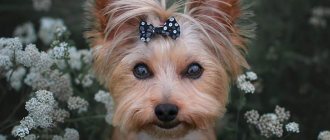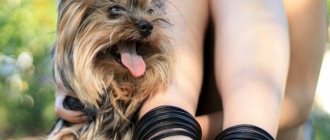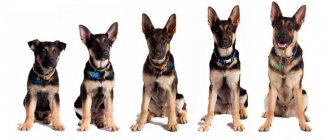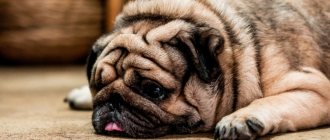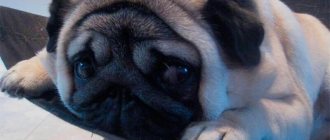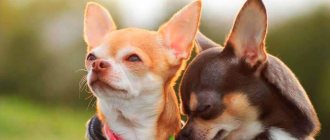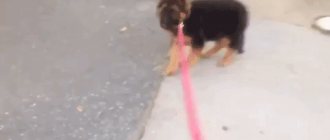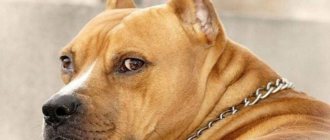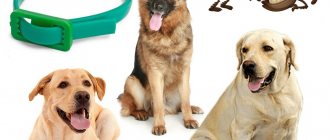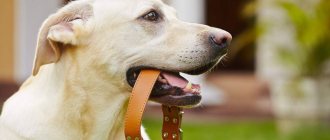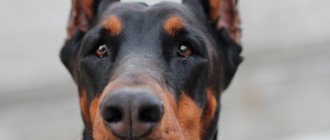The Yorkshire Terrier is one of the most popular miniature dog breeds. Yorkies are so small that they seem like toys; it is not for nothing that they are included in the toy terrier section according to the IFF classification (toy - from the English toy - “toy”). An important point when buying such a dog is its dimensions. To what age do Yorkies grow and what maximum size do they reach?
What influences the development of an animal
Yorkies are small dogs. Their height and weight, as well as their further development, are influenced by genetic factors. Sometimes, to produce small puppies, a standard partner is used for mating, and the partner is smaller than the female.
Various factors can influence the development of dogs
For your information! Mini Yorkie bitches are not used for breeding due to their inability to bear and give birth to offspring normally.
In addition to genetics, there are many other negative factors that affect the development of dogs:
- poor quality food;
- overnutrition of babies;
- poor living conditions;
- lack of essential vitamins and minerals;
- eating disorder;
- use of unacceptable treats in large quantities to reward;
- infection with worms;
- long-term infectious diseases;
- poor health from birth;
- increased calorie intake with low energy expenditure;
- disruption of the endocrine system;
- pathologies of the liver and cardiovascular system.
Note! The development of puppies can also be affected by certain body structure features and imbalances in proportions. The life expectancy of individuals with non-standard sizes is less than that of dogs that meet all standards.
Breed characteristics of Yorkies
Yorkshire Terriers are small dogs, with an average weight of 2-3 kg, and a fairly early development. Yorkies have a long coat, without undercoat, with a hair-like structure. Dogs of this breed have an accelerated metabolism - they quickly burn energy, which requires compensation with high-calorie food. Particular attention should be paid to this during the period of growth and development.
Such breed characteristics are the cause of “eternal hunger” in Yorkies - having quickly used up the energy received from food, they want to eat again . And this is precisely the main mistake of inexperienced owners who rush to compensate for their pet’s hunger with too frequent meals.
Remember! The Yorkie's diet is not too different from other dog breeds if the puppy receives high-calorie food in its diet with a sufficient content of meat ingredients and easily digestible carbohydrates.
Establishing the feeding behavior of any dog begins with organizing a place for feeding.
Vices of non-standard dogs
Representatives of the breed that do not meet the standard have a lot of health problems. So, in Yorkies that are too light, the following are most often observed:
- Hypoglycemia.
- Drowsiness, lethargy, lack of coordination of movements caused by hypoglycemic shock.
- Digestive problems.
- Periodontal disease.
- High probability of fractures.
- Joint diseases.
- Dislocation of the kneecap.
- Tracheal collapse.
- Otitis.
- Cryptorchidism.
- Non-overgrowing fontanel.
- Legg-Calvé-Perthes syndrome.
- Intolerance to anesthesia.
Also, female mini or micro Yorkies are not allowed to breed - they cannot bear and give birth to healthy puppies on their own. To get small puppies, standard females are mated with small males. The structural features of the Baby Face Yorkie's muzzle are the cause of chronic conjunctivitis (due to a narrow tear duct and frequent eye injuries) and breathing problems, which is why the dog can “grunt” while moving and snore.
The life expectancy of non-standard representatives of the breed is much lower: 10 - 12 and 7 - 9 years for mini and super mini Yorkies, respectively.
Creating conditions for the dog
When a puppy arrives, it is important to provide him with comfortable conditions for development. A small Yorkie needs good nutrition, active exercise and proper rest. Creating a place to rest is an important stage in preparing comfortable conditions for the dog. It is necessary to create a “shelter” for the puppy to rest, even from the owners. A place to rest can be presented in the following form:
- soft bedding with low sides and sufficient size for the dog to crawl into it and stretch its paws;
- bedding made of natural material with replaceable covers for easy washing;
- house - booth;
- a thick and soft blanket in a secluded corner of the apartment.
Recommendations for choosing a place to stay:
- the litter should not be in a draft or passage;
- the resting place should have a good view of the entire apartment and the owners;
- There should be no objects dangerous for the puppy (wires, dangerous plants) near the resting place;
- the place should be bright;
- the litter must be clean and dry;
- the resting place should be located away from direct heat sources (batteries, radiators, sun rays);
Even if the dog sleeps in the bed with you, it should have its own place.
To feed the puppy, you should choose a place where the animal will not be disturbed. In city apartments this is usually the kitchen or bathroom, as they are the easiest to keep clean. In addition to the food bowl, feeding requires:
- a bowl for water (preferably ceramic);
- adjustable stand for the bowl (to avoid neck strain and spine problems in the future).
A bowl of filtered water should always be available to the dog, and the water in it should be changed at least once a day.
Yorkshire Terriers do not always require walking. They can be trained to go to the toilet in a litter box at home. Regarding the toilet space, the following requirements must be met:
- the tray should not be in the aisle;
- It is better to place a disposable diaper in the tray;
- for male dogs, a tray with a post is required;
- the toilet should always be accessible to the dog;
- the toilet area should be easy to clean;
The presence of a litter box in the house does not mean that walks should be canceled altogether.
Yorkshire Terriers love to walk; fresh air and good weather are the key to a happy and healthy pet.
Stages of growing up by month
The growth of a puppy can be tracked by months. Gradually it will be noticeable how the baby develops and grows. How many months do Yorkies grow and when do they become adults?
Newborns
Chihuahua weight by month and week: table
Puppies are born blind and deaf. They practically do not move, spend more time sleeping, and eat the rest of the time. Newborn Yorkies are highly dependent on their mother: she feeds them, licks them, and they bask next to her.
Important! It is not recommended to pick up such babies; it stresses out the mother dog. It is better to wait until the puppies begin to move independently, see and hear.
1 month
Newborn Yorkie puppies have their tails docked; when they are 1 month old, the wounds heal. During the first two weeks, the puppies' eyes open and their hearing gradually normalizes. At one month old, babies become very curious, so they need to ensure safety throughout the house.
At the age of 4 weeks, the Yorkshire Terrier gains weight very quickly and becomes almost 3 times larger. The baby is already walking and sometimes tries to run. During this period, you can begin to accustom the dog to new food, gradually moving it away from its mother.
Newborn babies cannot see or hear
2 month
At this time, separation from the mother occurs. The babies become independent and can be given to another owner. Puppies learn quickly, it is important to explain to them many rules of behavior and begin training. Misdeeds are easily punished, successes are rewarded.
Note! At 2 months, babies are already comfortable eating solid food. The new owner must carefully transfer him to a diet that will be followed constantly.
From 3 to 6 months
At this time, the puppy is actively developing: he gets to know the world, communicates with people and other animals. It is important to pay him more attention, train him, and communicate. From the third month, babies' ears begin to rise. This can happen in a variety of ways, so don't worry if your ears remain floppy for a long time.
From the age of 4 months, dogs begin to replace their milk teeth with permanent ones. The process is quite unpleasant, so babies may be nervous, not eat and have trouble sleeping.
From six months to 9 months
The puppy becomes a teenager. At this time, the dog’s character may deteriorate, it begins to be more mischievous and stubborn. However, patience and attention should be exercised so as not to frighten the animal or lose trust. You need to show dissatisfaction, but very carefully.
For your information! Bitches go into their first heat during this period. If further breeding is not planned, then the dog must be sterilized to avoid the further development of serious diseases.
Newborn puppies are very dependent on their mother
9 to 12 months
How old do Yorkies grow? The baby turns into an adult dog closer to one year. It stops growing rapidly, and its mass does not increase either. The dog needs to be switched to adult food and the optimal diet must be selected.
Old age for Yorkies is counted from 8 years, but the animal's life expectancy is approximately 12 years. At this time, it is recommended to change the food and, if necessary, the conditions for keeping the pet.
Feeding the puppy
An inexperienced dog breeder runs the risk of encountering many problems in organizing the nutrition of a Yorkshire Terrier puppy. Any deviation, even the most insignificant, in the diet threatens with serious disorders. Of course, the liver will suffer. It is susceptible to attacks by harmful fats; pork or lamb are rich in them. For a small puppy, these 2 products are contraindicated.
It is difficult to organize proper nutrition for a one-month-old puppy. He can only eat so little. The main things in his diet will be milk and dairy products: cottage cheese, sour cream, kefir. Learn to prepare milk soups for your pet, “Hercules” with milk.
If you get this puppy (one month old), this is wrong. The baby should be close to his mother. But for them, stores sell a substitute for bitch's milk. It will be suitable food for a puppy. Here you can also buy bottles with nipples that are suitable imitation of mother's nipples. It is unlikely that this baby learned to feed himself.
A month-old Yorkie puppy in your arms will not be a tragedy for you.
At two months of age, the baby will need more serious food. For example, boiled liver. They love her. You can give finely chopped meat. But it should not be confused with minced meat, which cannot be given even to an adult dog, not to mention puppies. It is not completely digested in the stomach, but accumulates and rots there. Nothing good can be expected from this process.
Your Yorkshire Terrier should be fed in such a way that it receives vitamins and various nutrients:
- Calcevit;
- Sea kale;
- Brewer's yeast;
- Fish fat;
- And the protein is optional, because you don’t expect huge muscles from your dog.
Despite all the undoubted usefulness of these remedies, you should not give any tablets without first consulting with a veterinarian on this issue in order to avoid various surprises. It’s not bad at all if you have a permanent doctor.
Pay attention to foods that are contraindicated for your pet. He is almost constantly in his arms, and together with his owner he ends up at the table, where there are a lot of all sorts of goodies. And the puppy is cute, I really want to please him. So he often gets cakes, pastries, sweets, and various buns and cookies. The dog is happy, he even asks for more, and the owner is touched and treats him again.
The baby eats sweets with pleasure - this is dangerous. These include diseased, damaged teeth, a diseased liver, festering eyes and many other problems. But this is not the whole list. You should forget about potatoes, cabbage, grains and legumes. And from the age of four months, it is time to exclude milk from the diet.
After
During the week after birth, you need to give your pet 1 tsp 2-3 times a day. milk with calcium. You should not feed your Yorkie meat; it can cause eclampsia, a severe form of toxicosis.
It is better to feed a lactating bitch with high-calorie ready-made industrial food.
You can bathe your dog only 7 days after birth; before that, only wiping with a damp towel is allowed.
Puppy weight by month in the table
German Shepherd weight by month: table
The Yorkie's weight changes by month are shown in the table below.
| Age | Weight |
| newborns | 160 g |
| 1 month | 595 g |
| 2 month | 940 g |
| 3 months | 1280 g |
| 4 months | 1760 g |
| 5 months | 2040 |
| 6 months | 2240 g |
| One and half year | 2730 g |
This table is only an example. Don't worry if the weight differs slightly from the standard parameters. In general, the puppy quickly catches up with the required indicators. The dimensions (length and width) of the baby are not recorded, because the puppy may not immediately grow in proportion. The dog should be measured as an adult. For normal development, your dog will need various vitamins and minerals.
After reaching several months, puppies begin to actively explore the world
Rules for training at home
When raising and training a Yorkshire Terrier, you should adhere to several rules:
- Yorkie training begins as early as possible.
- To teach a puppy new things, move from simple to complex.
- At the initial stage, it is better to train the Yorkshire Terrier at home so that the dog is not distracted by anything during training.
- During one training period, you need to teach the Erka to carry out a single command.
- In the process of education they show persistence in order to achieve results.
- When addressing a yorik, they always call him by his name.
- The tone of communication should be calm and friendly.
- For training, choose a moment when both the owner and the Yorkshire Terrier are in a good mood.
Possible complications
The birth of a Yorkshire Terrier most often occurs without complications. Problems arise if the bitch has a narrow pelvis and is unable to give birth on her own. In this case, a caesarean section is required. A sign of the need for surgery is a dirty gray discharge that appears shortly before birth. It is also important to ensure that during birth all the placenta comes out - their number should be equal to the number of puppies. Placences that do not come out during childbirth may come out within 24 hours afterward; if this does not happen, the dog must be shown to a veterinarian.
Walking a Yorkie
Yorkshire Terriers are energetic and cheerful dogs. They enjoy taking part in active walks, however, physical activity should be moderate. Some recommendations for owners during the walk:
- contact with stray animals that can be carriers of diseases is limited;
- the puppy is walked 5-6 times in a quiet place so that it gradually gets used to the environment;
- take toys with you;
- the dog is treated in advance for parasites;
- the animal dresses according to the weather;
- walks at the same time (to develop a routine).
Height and weight of an adult Yorkshire Terrier
The required minimum weight and height of Yorkies is not specified in the standards. It is important that the weight does not exceed a certain value, the possible maximum is 3.2 kg.
Kitten weight by month: correct ratio table
An adult girl of this breed weighs on average 2.7 kg, the weight of boys is slightly higher and can reach 3.2 kg. These indicators are important for animals performing at exhibitions and participating in breeding. For pets, the norms are not considered particularly important, provided that the dog does not have diseases and does not develop obesity.
For your information! It is impossible to accurately determine the weight of an adult animal from a puppy. However, there is a method that is sometimes used - the weight of the baby at 8 weeks is multiplied by 3. The resulting figure is the approximate weight of an adult pet.
Subtleties of education
Yorkshire Terriers are dogs that everyone loves without exception. They look very cute and touching. Probably, it is precisely because of such a pretty appearance that many owners spoil their pets. Like any other dog, the Yorkie needs human interaction. But at the same time, the animal can quite easily spend 8-10 hours alone. As soon as the puppy arrives in your home, leave him alone. If you overindulge your baby in the company of his owners, he will get used to it and begin to whine and howl every time he is left alone.
Having a place of your own is very important for a dog, and the Yorkshire Terrier puppy is no exception. 3 months is the optimal age for a baby to move to his own owners. You can arrange bedding for your pet or buy a special house. Do not take an animal into your bed even “for once.” If your puppy whines in his bed, it may be because he is cold. Put your baby on a heating pad and monitor the temperature in his house from now on. Be sure to pamper your pet with toys; balls and various squeakers will not let him get bored. If you regularly walk your pet, be sure to ensure that he does not pick up anything from the ground. The dog should be weaned from this harmful and dangerous habit as early as possible.
A little about sizes
The official breed standard adopted by the FCI and RKF does not provide for the division of Yorkshire terriers into varieties by weight or appearance. However, in accordance with the conventional gradation common among dog breeders, Yorkies are divided into:
- Standard – from 2 to 3.2 kg.
- Mini – from 1.4 to 2 kg.
- Super - mini or micro - up to 1.5 kg.
Separately, it is worth noting baby face Yorkies, which are characterized by a shorter muzzle (its length is a third of the length of the skull), a snub nose and large bulging eyes. Varieties of mini, super-mini, micro and baby face Yorkshire terriers are not related to the breed standard and initially did not carry breeding value and were not of interest to breeders, but over time they became fashionable and became widespread.
Why do you need to train Yorkies?
Raising and training a Yorkshire Terrier helps to avoid the creation of unwanted situations. Gradually, the puppy understands how to behave and ceases to be uncontrollable. You can expect everything from an ill-mannered Yorkie - barking at others, aggression. They can pick up food from the ground, bite, and jump on their owners’ beds and tables. The dog is capable of running away, getting hit by a car and getting injured. Education, training and teaching basic commands help make a dog's behavior predictable and his life safe.
Gaining weight and height in Mini Yorkies
The breed is not clearly divided into several species, but Mini Yorkies are often distinguished separately. The change in weight in such babies can be seen in the table below:
| Age | Weight |
| newborn | 115 g |
| 1 month | 370 g |
| 2 months | 610 g |
| 3 months | 850 g |
| 4 months | 1110 g |
| 5 months | 1300 g |
| six months | 1450 g |
| one and half year | 1820 |
As adults, Mini Yorkies weigh approximately 2 kg. Babies who do not meet the norm are more likely to be susceptible to various diseases and have a lower life expectancy.
A properly selected diet is the key to a puppy’s good development.
At what age should you start training and raising a puppy?
Already at the age of one month it is necessary to raise a Yorkshire Terrier. Most often, the breeder teaches him the first skills, since puppies are sold no earlier than two months.
Training is carried out according to plan:
- At the age of 1-2 months, they are accustomed to a nickname, a toilet, and the commands “Come to me!” and “Place!”
- At 3 months, raising a puppy consists of developing the skill of wearing a collar, walking on a leash, and following the commands “Sit!”, “No!”.
- At 4-5 months they practice the commands “Near!” and “Lie down!”
- At 6-8 months, they repeat previously acquired skills and carry out the orders “Bring it!”, “Fu!”, “Give me a paw!”
- From 8 months to a year, the Yorkshire Terrier is actively socialized and reinforced what has been learned.
Necessary preparation for childbirth
Giving birth to a Yorkie at home is not something scary if you prepare for it in advance. If difficulties or questions arise, it is recommended to consult a veterinarian.
The first and most important thing you need for childbirth is a place. It should be secluded and warm. You can use a special oilcloth as bedding. Also, a bowl of water and food must be placed next to this place.
Important! It is best to stock up on more disposable diapers. In the future, they will also be useful for postpartum care.
To process puppies you will need:
- pipette to remove mucus from the nose;
- sterile scissors to cut the umbilical cord;
- thread, cotton wool and brilliant green - for processing.
In addition, just in case, you should acquire the following medications:
- calcium gluconate;
- oxytocin;
- no-shpa;
- diphenhydramine;
- saline;
- alcohol;
- brilliant green;
- syringes.
The veterinarian will tell you in detail about their possible use. Owners who have never given birth are advised to consult with a specialist and clarify all questions of interest.
Important! Long hair will only get in the way during childbirth. Therefore, the dog should be trimmed in the belly and groin area. It will also be necessary to trim the animal's claws.
Shaving the belly
Choosing a place and dishes
This issue should be resolved before the puppy arrives in the house, and it is correct if the chosen place for feeding does not change in the future. Since these small dogs do not require large areas for their “table,” bowls can also be placed in the kitchen. For food and water you need separate dishes that need to be washed regularly.
It is better to choose dishes made of stainless steel - this is the optimal price-quality ratio, but you can also buy plastic and ceramic ones. The bowl is selected so that a single portion of food occupies approximately 2/3 of its volume. Since puppies turn over plates when feeding, it is worth purchasing a special mat on which the bowl will not “slip.”
Special devices are very convenient for feeding - rods, table tops with holes. All these attributes are sold in pet stores, and a consultant will help you decide.
The so-called ball drinker, otherwise called “dry whiskers,” has become very popular, designed specifically for bearded and mustachioed dogs. With such a device, you can safely leave your dog for the whole day without worrying that he won’t have enough water.
What to do if the puppy is behind the norm
Often owners are concerned that the puppy does not reach the required weight and size by a certain age. In this case, you should not immediately worry and worry; the standard indicators in most cases are average.
All dogs are individual and develop differently; by the age of one and a half years, they usually reach normal weight and size.
Note! Children often do not eat well when their teeth change.
The owner is advised to carefully review the baby’s diet; perhaps the necessary vitamins and minerals should be added. It is important that the food contains enough fats, proteins and carbohydrates. It is worth selecting it according to the age of the dog and giving preference to a quality product. However, you should also not overfeed your puppy, as this can lead to obesity.
It is necessary to carry out antihelminthic prophylaxis on time, because parasites can also cause a lack of required weight.
If the problem is critical, it is recommended to visit a veterinarian. You may need to undergo tests and find the appropriate treatment. It is important to check your baby in time for the presence of serious infectious diseases that can cause disruption of the digestive system and weight loss.
It is important to provide quality physical activity to Yorkies
Prohibited Products
Like all other dog breeds, Yorkies have their own list of prohibited foods:
- boiled bones (especially tubular chicken bones);
- white bread and rolls;
- spices, salt and sugar;
- chocolate products;
- canned food, smoked meats and pickles;
- sausages;
- raw pork;
- River fish.
This is a general list of foods that are harmful to any dog. It is worth consulting with the puppy's breeder, because even when breeding dogs within the same kennel, there may be some deviations and additions.
Similar signs
By the dog's behavior before giving birth, you can determine when it will start giving birth.
- 4 - 5 days before giving birth, the dog experiences a slight sagging of the back caused by prolapse of the uterus.
- Also, the imminent birth can be judged by rapid breathing and a decrease in body temperature.
- Some individuals begin to get nervous 7-10 days before giving birth and refuse to eat, others, on the contrary, eat more, behave as actively as possible, and like to take long walks.
- Before giving birth, the bitch behaves restlessly, looking for a quiet and secluded place where she will be comfortable giving birth and feeding puppies.
The dog should not be allowed to hide - the birth should take place in full view of the owners so that they have the opportunity to help the puppy or bitch.
Video
Video about what you need for a puppy.
Nutrition
The health and development of your Yorkie depends on proper nutrition. Ask the breeders what they fed the puppies. It is advisable to continue feeding the dog the same: a sudden change in food can lead to digestive problems. The diet change should be gradual. You need to give food in small portions several times a day:
- up to 2 months – 6 times a day;
- 2 – 4 months – 5 times;
- from 4 to 6 months – 4 times;
- 6 – 10 months – 3 times;
- By the age of one year, the dog should eat twice a day - morning and evening.
What to feed?
Yorkshire terriers can be fed prepared food of at least premium class, for example, from Royal Canin or natural homemade food. The daily diet should consist of 50% protein foods (meat, fish, cottage cheese), 25% carbohydrates (buckwheat or rice porridge) and 25% fruits and vegetables.
When feeding your dog at home, you will need mineral and vitamin supplements.
Water treatments
After a walk, your Yorkie needs to wash his paws and belly. A thorough wash is carried out every 10 days. You can bathe your dog in a large basin, bathtub or sink. The ears are covered with cotton swabs to prevent water from entering. Under a slight pressure of water, the fur is generously wetted, then shampoo is applied and the dog’s body is delicately massaged, after which it is thoroughly rinsed with water. To prevent your Yorkie from freezing, wrap it in a terry towel, let it dry a little on its own, or dry it with a warm stream of a hairdryer, while combing the fur.
If you apply a conditioner after shampoo, your pet’s coat will shine and become less tangled.
Ears
Ears should be cleaned and inspected weekly. A cotton swab dipped in a special lotion removes plaque and dirt. After cleaning, you need to cut off the excess hair to 1/3 of the ear. It is convenient to remove excess hairs with a trimmer or machine.
Eyes
Every morning you need to wipe your Yorkie's eyes with a cotton pad soaked in chamomile infusion or warm boiled water. The fur around the eyes is smoothed in different directions with wet fingers or cut so as not to injure the eye.
Nails
If the dog walks often, the claws wear down on their own. If this does not happen, then several times a month the claws are trimmed with a claw cutter - guillotine or filed with a nail file every 4 - 5 days.
Wool
Yorkshire terriers need to be brushed daily, as their coat is thin and tangles can form on the third day. To make combing easier, the coat can be sprayed with a special spray. The bangs are collected in a ponytail so that they do not get into the eyes or cut off. You need to remove split ends every 3-4 months. If you got a dog for yourself, then you can do the hairstyle yourself, but if it’s for exhibitions, it’s better to turn to specialists. Adult Yorkies are sometimes given nourishing coat masks based on oils (linseed, jojoba, almond, coconut, burdock).
Teeth
Puppies' baby teeth change by 5–7 months. Care must be taken to ensure that baby teeth fall out on time to prevent malocclusion. Teeth are brushed daily with a special toothpaste and brush. For babies, the oral cavity is treated with gauze soaked in warm water. Every six months you need to contact your veterinarian for a professional teeth cleaning.
Hygiene
To maintain hygiene, your Yorkie needs to be washed every day after urinating . The fur under the tail, in the groin area and on the belly should be shortened so that it does not get dirty when going to the toilet.
Upbringing
Untrained Yorkies can cause a lot of problems. It is more difficult to retrain an adult dog, so training must begin from an early age. By three months, the puppy should already recognize its name, know basic commands (place, come to me, ugh) and understand where to go to the toilet.
Toilet training
Yorkshire terriers can be trained to relieve themselves in a litter box or on a special diaper. To do this, you need to be patient and closely monitor the puppy. Kids go to the toilet after sleeping or eating, so at this time you need to take the dog to its toilet and praise it after finishing its “tasks”.
The owner is the leader
If the owner does not dominate the dog, then the dog will take on this role and will happily bring chaos into your life. It is important to stop disobedience in a timely manner and not let the puppy feel like the boss in the house. To do this, remember a few rules:
- the dog should not sleep with the owner or spend time on sofas and armchairs;
- The family members eat first, then the pet. It is not allowed to feed the dog treats from the table;
- do not let the puppy run in front of you: you must set the direction of movement, not the dog. Teach your puppy to walk next to you on the left side.
Training
Yorkshire Terriers are very intelligent and easy to train. It is important that the training takes place consistently: until you learn one command, you do not need to take on the next one. After completing the command, be sure to praise the puppy with a treat or caresses.
Adviсe
In order for your puppy to obey you, you need to establish a trusting relationship with him. To do this, you need to adhere to several rules that will help prevent mistakes in education:
- You can't shout at the animal. Commands must be given in a firm, calm voice;
- If the dog has misbehaved, you should not raise your hand to him. It is more effective to use disapproving intonation;
- When you scold a puppy, do not mention its name. The dog should only have good associations with its name;
- training should be carried out regularly, preferably in different places;
- You don't need to raise your voice at your dog to get his attention. It’s better to create artificial noise: clap your hands or hit the table;
- In addition to voice commands, Yorkies respond well to gestures, so when giving commands, watch your movements.
The problem of obesity and how to lose weight
If the dog's diet is incorrect, then it is possible that the dog may exceed normal body weight. Yorkies are prone to obesity if they are overfed and not given the necessary exercise.
Excess weight often causes the development of serious diseases (diabetes, etc.), problems with joints and breathing, liver pathologies, and high blood pressure. Excess weight negatively affects appearance and life expectancy.
Getting rid of obesity is possible with strict adherence to the diet and a properly selected diet. All necessary substances must be present in food.
Important! The serving size and calorie content should be appropriate according to the dog's energy expenditure. The diet should be based on the age and size of the pet.
It is important to give Yorkies the necessary physical activity; this will allow the dog to spend more energy and maintain normal physical shape.
Knowing to what age Yorkshire terriers grow, you should choose the necessary diet in time and monitor the physical condition of the dog.
The weight of an adult dog depends on proper maintenance
Washing and grooming
A Yorkie's coat grows throughout its life. Typically, representatives of this breed among pets are cut quite short. The exhibition standard, on the contrary, is long wool. Short-haired animals can be bathed once every three weeks or more often as they get dirty. Show animals are washed every 10 days. During water procedures, the dog is placed in a bathtub and watered from the shower. Be careful to keep the inside of your ears dry. Apply shampoo diluted with water twice and rinse thoroughly. After this, you need to apply the balm and then rinse it off thoroughly. Immediately after completing the water procedures, the animal’s fur is dried with a towel and then dried with a hairdryer.
Caring for Yorkshire Terrier puppies includes a lot of rather complex hygiene procedures. And yet, washing is sometimes associated with a number of real problems. It is very important to get your pet used to blow-drying as early as possible. An equally significant component of Yorkie coat care is grooming. Grooming a Yorkshire Terrier should be done by a professional. The puppy must be taught to groom its coat from an early age. If the animal is a show animal, it must react adequately to the fact that a stranger or little-known person is doing the haircut. Many owners of Yorkies (pets) prefer to learn how to cut their dog's hair on their own under the supervision of a professional groomer. If the haircut is done for convenience, and there are no critical requirements for its shape, you can easily take care of your pet’s hair on your own. Still, it’s better to learn from a professional or even take special courses.
Dimensions and proportions of a Yorkie in accordance with the standard
The standard for this breed FCI No. 86 dated January 20, 1998 determines not only how much an adult dog should weigh and what its height at the withers should be, but also regulates the proportions of the animal: the position of the tail, paws, the shape of the skull and muzzle. Normally, the dog has a compact square body, a neck and muzzle of moderate length, a small and flattened head without roundness or significant protrusions.
A standard Yorkie should not be higher than 25 cm at the withers (height ideally coincides with the height at the croup). The length of the body from the withers to the base of the tail is no more than the length of the front legs; it is best if it is one and a half centimeters less than them.
The tail is usually docked to medium length and is held high by the dog, above the level of the back. The front and hind legs are straight. Limbs that are too short or long, as well as deviations from the norm in other parts of the body, are not allowed by the standard.
How much do classes with a dog trainer cost?
Raising a Yorshik is difficult for a novice dog breeder. The best option is to seek help from an experienced dog handler. A professional will teach the puppy how to follow commands, and the owner how to properly interact with the pet. Individual and group lessons have a greater effect in education and training than home lessons. The cost of the course depends on the complexity of the training. On average, the price of one lesson is 1500-1700 rubles, the entire course is 7000-15000 rubles. If it is necessary to correct the dog’s behavior, you will have to pay about 2,500 rubles for one lesson.
